Selecting the right materials for your signage is a crucial decision that can significantly impact its longevity, effectiveness, and overall appearance.
Whether you're designing signage for an event, exhibition, retail store, or any other purpose, understanding the different materials available and their suitability for various applications is essential.
In this article we will break down the differences between the most common signage materials, when and where to use them, and where to source quality stock.
1. Vinyl
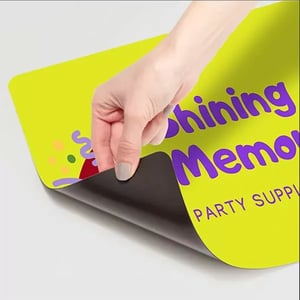 Suitability: Vinyl is one of the most versatile materials for signage and is commonly used for banners, window decals, vehicle wraps, and more.
Suitability: Vinyl is one of the most versatile materials for signage and is commonly used for banners, window decals, vehicle wraps, and more.
Pros:
- Durability: Vinyl is highly durable and can withstand outdoor conditions, including rain, wind, and sunlight.
- Versatility: It can be printed with vibrant colours and intricate designs.
- Cost-Effective: Vinyl signage is often cost-effective and provides excellent value for its durability.
Considerations:
- There aren't many downsides to vinyl but you do have a lot of options, so there might be a bit of a learning curve with regards to adhesive type or finish.
- Adhesive Type: Choose between permanent and removable adhesive options based on your signage's intended lifespan.
- Finishes: Vinyl comes in various finishes, such as gloss, matte, and textured. Select the one that complements your design.
2. Acrylic
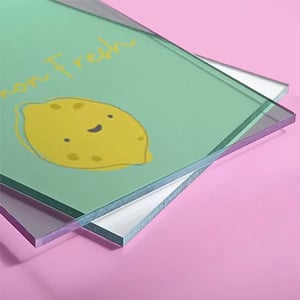 Suitability: Acrylic is often used for elegant indoor signage, such as office signs, lobby displays, and directional signs in upscale venues.
Suitability: Acrylic is often used for elegant indoor signage, such as office signs, lobby displays, and directional signs in upscale venues.
Advantages:
- Clarity: Acrylic signage offers excellent optical clarity and a premium, high-gloss appearance.
- Customisation: It can be cut into various shapes and sizes, and graphics can be applied directly to the material.
- Durability: Acrylic is resistant to fading and discoloration.
Considerations:
- Fragility: Acrylic can be brittle and may not be suitable for high-impact environments.
- Scratches: It can be prone to surface scratches, so proper care is essential to maintain its appearance.
3. Foam Board
 Suitability: Foam board is a lightweight material suitable for temporary indoor signage, presentations, and displays.
Suitability: Foam board is a lightweight material suitable for temporary indoor signage, presentations, and displays.
Advantages:
- Lightweight: It's easy to transport and install, making it ideal for events and short-term promotions.
- Affordable: Foam board is cost-effective for projects with budget constraints.
- Customizable: It can be easily cut, printed, and mounted.
Considerations:
- Durability: Foam board is not suitable for long-term outdoor use or high-traffic areas.
- Moisture Sensitivity: It can warp or deteriorate if exposed to moisture.
4. PVC (Polyvinyl Chloride)
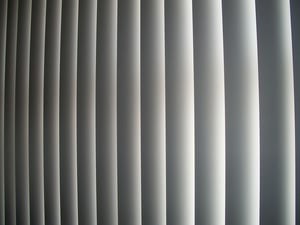 Suitability: PVC is versatile and can be used for indoor and outdoor signage, including menu boards, trade show displays, and directional signs.
Suitability: PVC is versatile and can be used for indoor and outdoor signage, including menu boards, trade show displays, and directional signs.
Advantages:
- Durability: PVC is weather-resistant and can withstand outdoor conditions.
- Lightweight: It's relatively lightweight compared to some other materials.
- Customization: PVC sheets can be printed, cut, and shaped to create a wide range of signage options.
Considerations:
- Environmental Impact: PVC is not environmentally friendly, and alternative materials may be preferred for sustainability reasons.
5. Foam PVC
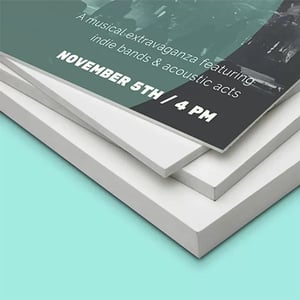 Suitability: Foam PVC, also known as Foamex, is a lightweight and durable material often used for indoor and outdoor signage.
Suitability: Foam PVC, also known as Foamex, is a lightweight and durable material often used for indoor and outdoor signage.
Advantages:
- Lightweight: Foam PVC is lighter than traditional PVC, making it easier to handle and install.
- Rigidity: It offers excellent flatness and rigidity, ensuring your signage maintains its shape.
- Weather-Resistant: It can withstand outdoor conditions and is resistant to UV rays.
Considerations:
- Printing Quality: The quality of printing on foam PVC can vary, so choose a reputable printing service to ensure vibrant and long-lasting graphics.
6. Correx (Corrugated Polypropylene)
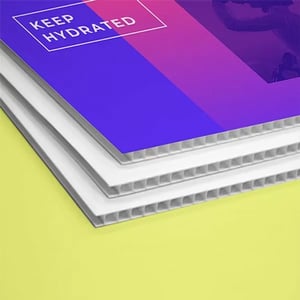 Suitability: Correx, or corrugated polypropylene, is a cost-effective material suitable for temporary outdoor signage, event signage, and construction site signs.
Suitability: Correx, or corrugated polypropylene, is a cost-effective material suitable for temporary outdoor signage, event signage, and construction site signs.
Advantages:
- Lightweight: It's easy to transport and install, making it ideal for short-term signage needs.
- Waterproof: Correx is highly resistant to water, making it suitable for rainy or damp conditions.
- Affordability: It's a budget-friendly option for temporary signage.
Considerations:
- Durability: While Correx is suitable for temporary use, it may not hold up well for long-term outdoor applications.
7. Dibond
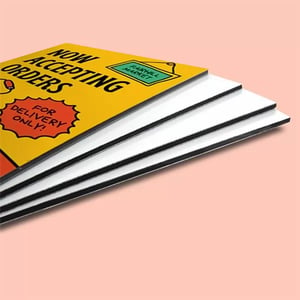 Suitability: Dibond is a rigid composite material consisting of aluminium layers with a solid polyethylene core. It's commonly used for outdoor signs, building cladding, and durable directional signs.
Suitability: Dibond is a rigid composite material consisting of aluminium layers with a solid polyethylene core. It's commonly used for outdoor signs, building cladding, and durable directional signs.
Advantages:
- Durability: Dibond is highly weather-resistant and can withstand outdoor conditions for extended periods.
- Stability: It remains flat and stable, making it ideal for large-format signage.
- Professional Appearance: Dibond provides a sleek and professional appearance.
Considerations:
- Cost: Dibond signage tends to be more expensive than some other materials, which may impact your budget.
8. Re-board (Recyclable Cardboard)
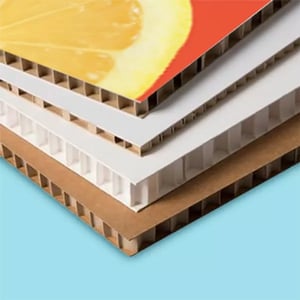 Suitability: Re-board, also known as recyclable cardboard, is an eco-friendly and lightweight material suitable for various indoor signage applications, including point-of-purchase displays, trade show booths, and exhibitions.
Suitability: Re-board, also known as recyclable cardboard, is an eco-friendly and lightweight material suitable for various indoor signage applications, including point-of-purchase displays, trade show booths, and exhibitions.
Advantages:
- Eco-Friendly: Re-board is made from recyclable materials and is an environmentally responsible choice for signage.
- Lightweight: It's exceptionally light, making it easy to transport and install, particularly for large displays.
- Customization: Re-board can be printed with high-quality graphics, making it suitable for visually appealing signage.
Considerations:
- Durability: While Re-board is sturdy for indoor use, it is not designed for extended outdoor exposure.
- Weight Limitations: It may not support heavy items or structures, so assess your signage requirements carefully.
Where can I learn more about event signage?
To learn more about effective signage, check out our Ultimate Guide. You'll learn what makes good signage effective, different types and purposes of signage, how to measure the impact of signage and how to install and maintain it.
